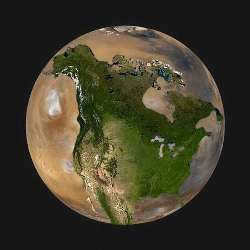
Science
Understanding the vastness of the universe and the scale of its planets and stars can be challenging, especially when comparing them to the size of our Earth.
In an attempt to illustrate the size of objects in our galaxy, British astronomer John Brady has taken the continents of Earth and placed them on celestial bodies.
Many of these objects are so enormous that accurately representing their size is a difficult task.
An Analysis of the Magnitude of Planet Earth in Relation to Other Celestial Bodies
Examining the Neutron Star
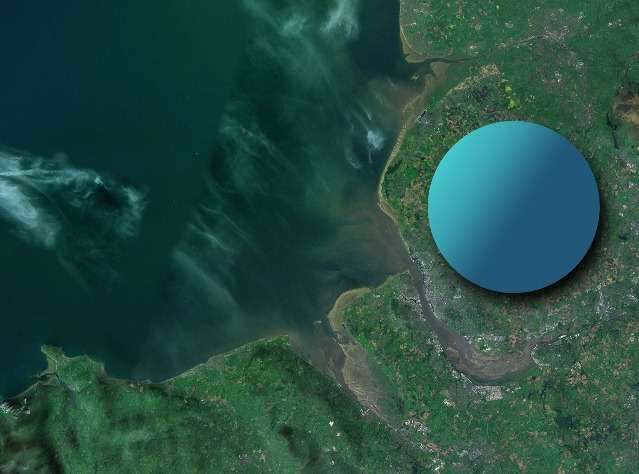
Comparing a neutron star to the northeast of England
A neutron star is an object that is quite peculiar and unique. Despite its diameter being only 20 kilometers, it possesses a mass 1.5 times that of the Sun due to its incredibly high density.
It is so dense that a teaspoonful of it would weigh a billion tons. Furthermore, if one were to stand on its surface, they would experience a gravitational force that is 200 billion times stronger than that of our planet.
In addition, a neutron star has the ability to spin, with the fastest neutron star rotating 716 times per second.
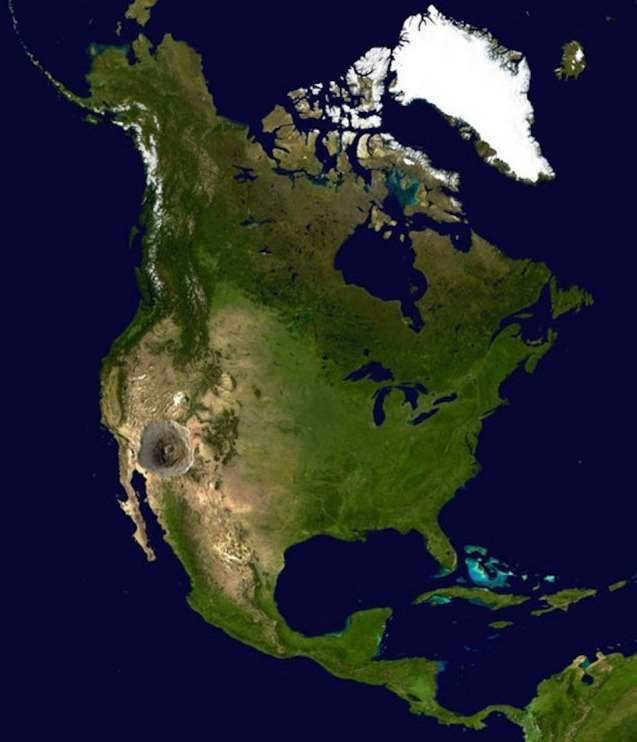
Located in the state of Arizona is the Martian volcano Olympus.
Despite Mars being a relatively small planet, it is home to the largest volcano in the solar system – Mount Olympus. This magnificent volcano stands at a height of 26 kilometers and spans a width of 624 kilometers, making it three times taller than Mount Everest.
Crowning this extraordinary formation is a caldera with a diameter of 80 kilometers.
Jupiter’s moon Io
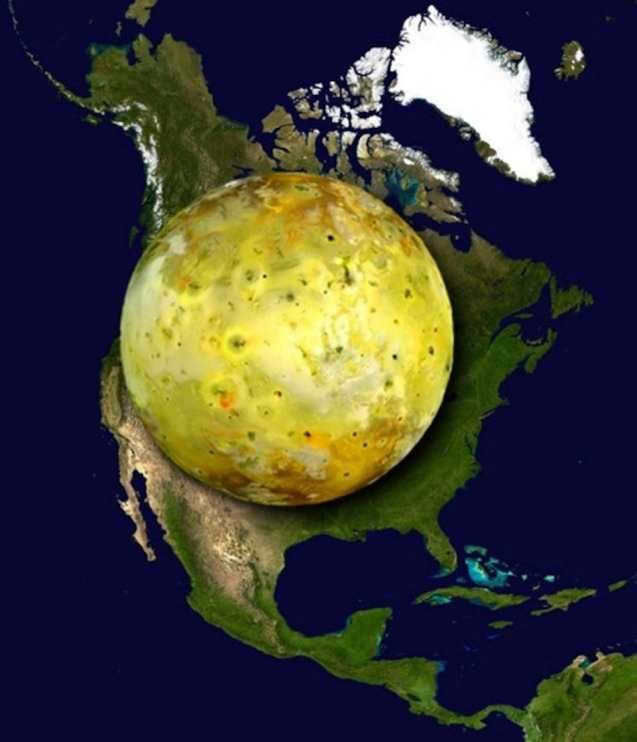
Comparing the size of Jupiter’s moon, Io, to North America
Jupiter’s moon, Io, is the most volcanic celestial body in our solar system. It has a diameter of 3,636 kilometers and is similar in size to our own moon. However, Io is much smaller than Jupiter, as it is located 350,000 km away from the gas giant (equivalent to 2.5 times the size of Jupiter).
Due to the strong gravitational pull of Jupiter, Io’s core is molten, resulting in volcanic activity on its surface. These volcanic eruptions release lava, which covers Io in a yellow sulfur coating. The height of these lava flows is so immense that if they were occurring on Earth, they would surpass the height of the International Space Station.
The dimensions of the stars and planets within our solar system
The Red Planet: Mars
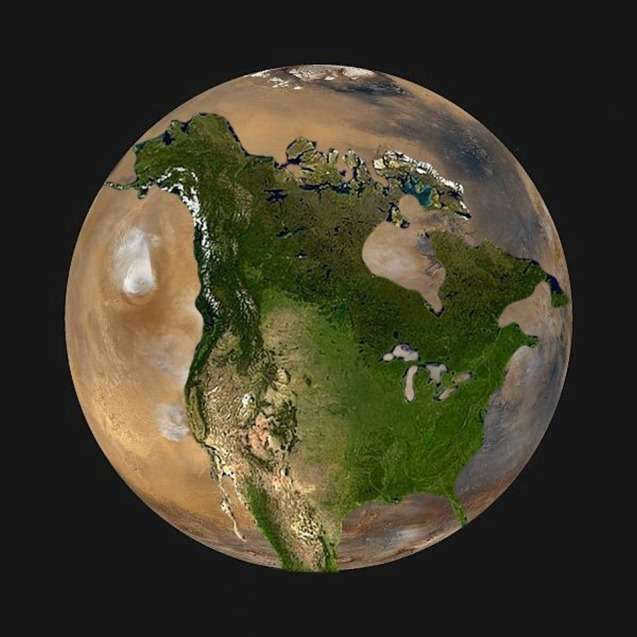
Comparison between North America and Mars.
Mars is not as large as it may appear. If you were to travel from one side of Mars to the other, it would take approximately 8 hours. The equatorial diameter of Mars is 6792 kilometers, and it is 40 kilometers smaller from pole to pole.
Mars is the second smallest planet in the solar system, after Mercury. Interestingly, Mars has a land mass similar to Earth, although it is significantly smaller and lacks oceans.
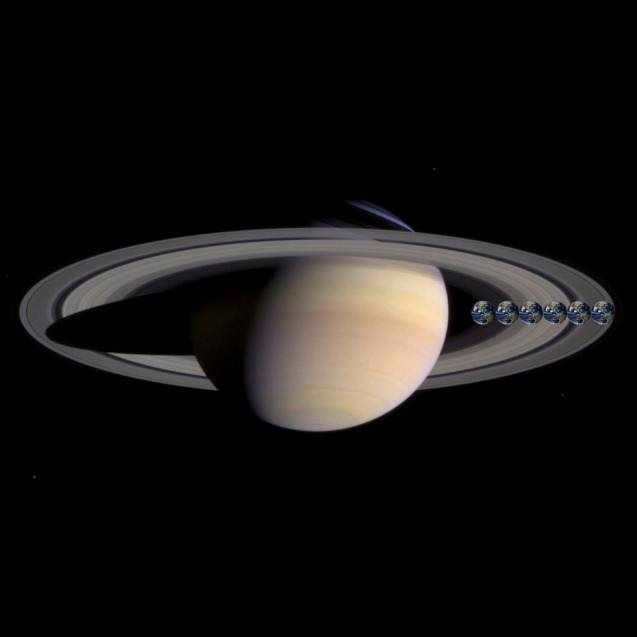
The image demonstrates the vast difference in size between Saturn and Earth.
When considering the width of Saturn’s rings, it becomes evident that it could accommodate 6 Earth-sized planets.
Furthermore, if we were to measure the diameter of Saturn’s main disk, we would find that it is large enough to fit nearly 10 Earth-sized planets. Additionally, if we were able to fill the space inside Saturn, it would have the capacity to hold a staggering 764 Earths.
The rings of Saturn.
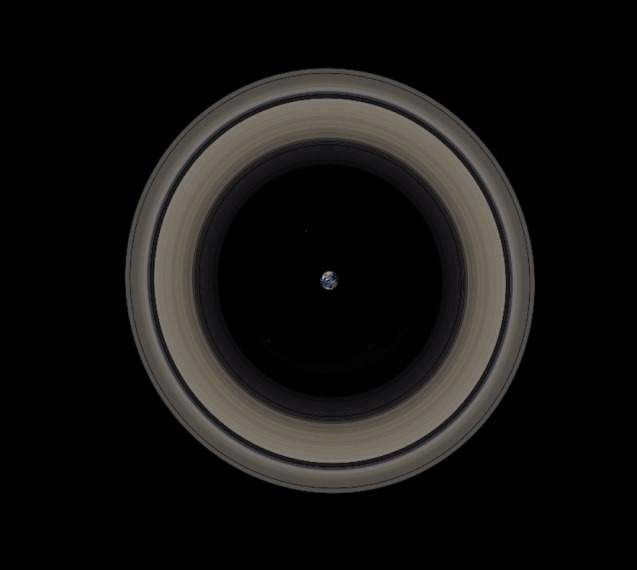
If Earth were positioned in place of Saturn’s disc, this is how our planet would appear.
Saturn’s rings consist of countless particles, ranging from minuscule grains to massive blocks.
The rings have a thickness of up to 1 kilometer, and the gap between the inner and outer rings measures 282,000 kilometers, which is three quarters of the distance between Earth and the Moon.
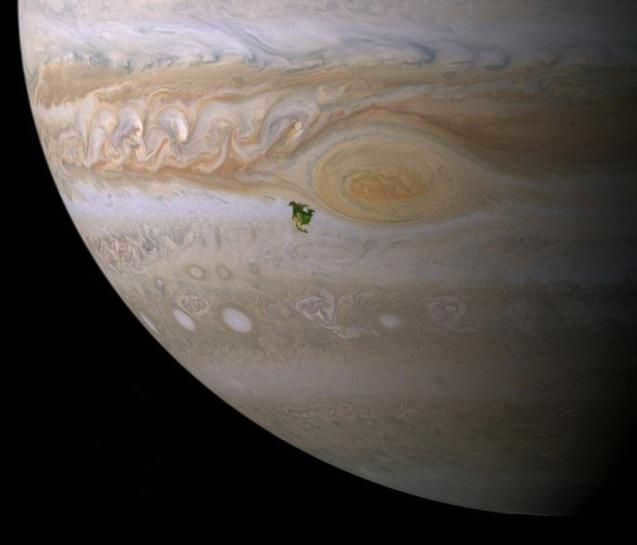
The size of North America compared to Jupiter
Jupiter, the largest planet in the solar system, has a mass greater than that of all the other planets and satellites combined.
With a diameter of 142,984 kilometers at the equator, Jupiter is 11 times larger than Earth. Lightning on Jupiter is 1000 times more powerful than on Earth, and wind speeds in its upper atmosphere can reach 100 meters per second.
Additionally, Jupiter is the fastest rotating planet, completing a full rotation around its axis in just 10 hours (compared to Earth’s 24 hours).
The Sun
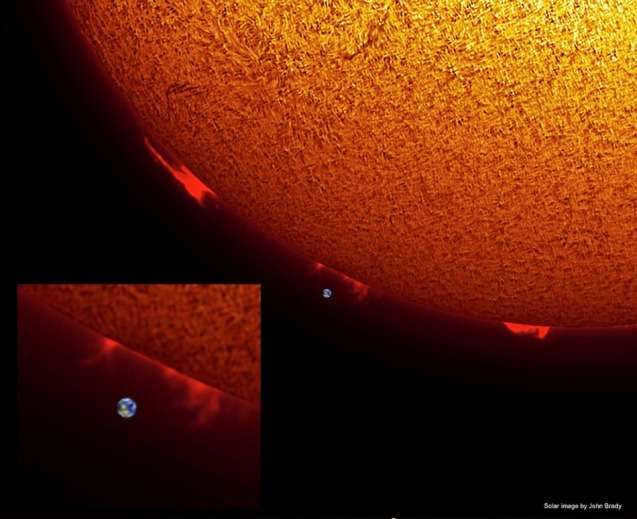
Comparing the size of Earth to the Sun
The Sun accounts for 99.86% of the total mass of the solar system. This implies that our planet Earth, as well as other planets and satellites, are merely remnants of the Sun’s formation 4.5 billion years ago.
A single sunspot is larger than the Earth itself. The diameter of the Sun is large enough to accommodate 109 planets similar in size to Earth, and it would require 1,300,000 Earths to fill the volume of the Sun. 1,300,000 Earths.
Upon closer examination, the Sun appears to be granular, with up to 4 million of these granules spanning the diameter of the Sun’s disk, each measuring up to 1000 km in size.
However, it is important to keep in mind that the Sun is merely one of many billions of stars within the Milky Way galaxy.
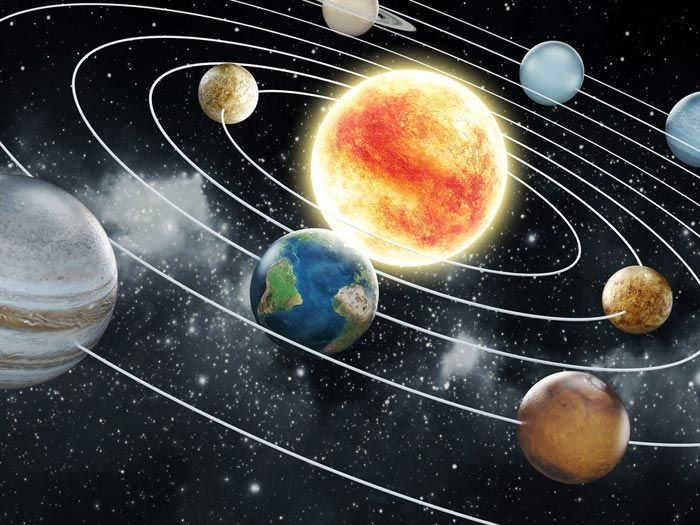
The Sun, our celestial parent, reigns over the solar system, which encompasses a total of eight planets as well as numerous other astral entities. Differing in magnitude and composition, these planetary bodies traverse their designated orbits, some in close proximity to our fiery star, while others reside at considerable distances.
Description of the Solar System
Before 2006, it was widely accepted that there were a total of 9 planets in our solar system. However, during the subsequent International Astronomical Congress, Pluto, the farthest object from the Sun, was removed from the official list of planets. Scientists reevaluated the criteria for what constitutes a planet and decided to only include celestial bodies that met the following parameters:
- They must orbit around a star, specifically the Sun.
- They must have a spherical shape and possess sufficient gravity to maintain this shape.
- They must not be in close proximity to any other large cosmic bodies, apart from their own natural satellites.
The planets that meet these revised criteria and are currently recognized as part of our solar system are listed below in order of their distance from the Sun:
- Mercury. It has a diameter of approximately 4.9 thousand kilometers.
- Venus. It has a diameter of approximately 12.1 thousand kilometers.
- Earth. It has a diameter of approximately 12.7 thousand kilometers.
- Mars. It has a diameter of approximately 6.8 thousand kilometers.
- Jupiter. It has a diameter of approximately 139.8 thousand kilometers.
- Saturn. Its diameter is approximately 116.5 thousand kilometers.
- Uranus. Its diameter is about 50.7 thousand kilometers.
- Neptune. Its diameter measures around 49.2 thousand kilometers.
Attention! Scientists have been prompted to revise their parameters due to the discovery of another planet-like body called Erida, which has been found to be heavier than Pluto. Both objects have now been categorized as dwarf planets.
The members of the Earth group: Mercury and Venus
Within the Solar System, the planets are categorized into two distinct clusters: the terrestrial (inner) planets and the gaseous (outer) planets. These two groups are partitioned by the asteroid belt, which some theories propose to be remnants of a failed planet formation caused by the dominant gravitational pull of Jupiter. The terrestrial group comprises planets that possess a solid surface.
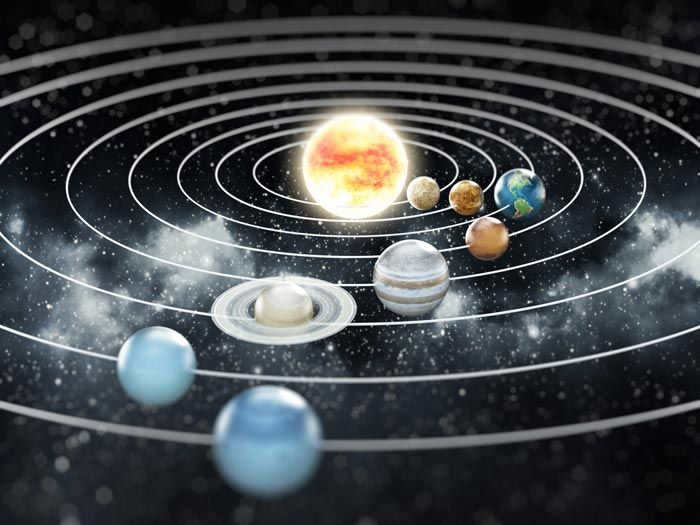
Mercury is the initial object in the solar system, located closest to the sun. It has the smallest orbit and revolves around the sun at a faster rate compared to other planets. The duration of a year on Mercury is equivalent to 88 Earth days. However, Mercury has a slow rotation on its axis, resulting in a longer local day than the local year, which lasts for 4224 Earth hours.
Attention! The movement of the sun in the dark sky of Mercury is highly distinctive from that on Earth. Due to the unique characteristics of its rotation and orbit, the sun may appear to stop, “pivot”, rise, and set multiple times within a single day at various points on Mercury.
Venus is the second planet from the Sun, and it possesses a unique atmosphere consisting mainly of carbon dioxide, which makes up over 96% of its composition. This dense atmosphere has long kept its surface hidden from human observation. Unlike its neighboring planet Mercury, Venus is incredibly hot, with temperatures reaching up to +460°C. This extreme heat is primarily caused by the greenhouse effect, which is a result of the atmospheric density. Furthermore, the surface of Venus experiences a tremendous amount of pressure, approximately 92 times that of Earth. Beneath the thick layer of sulfuric acid clouds, there are constant hurricanes and thunderstorms that never cease.
The planets of the Earth group: Earth and Mars
Earth is the largest planet in the Earth group and the only one that is suitable for life. It has a diverse atmosphere consisting of nitrogen, oxygen, carbon dioxide, argon, and water vapor. The planet is protected by an ozone layer and a magnetic field, which are crucial for the existence of life. Earth also has a natural satellite called the Moon.
Mars completes the quartet of planets in the Earth group. This planet has a thin atmosphere and a rugged surface with craters, valleys, deserts, extinct volcanoes, and polar glaciers. Among its features is Olympus, a massive volcano that stands as the tallest peak in the entire solar system, measuring 21.2 km in height. It has been discovered that Mars was once covered in water, but today, only ice and dusty whirlwinds can be found on its surface.
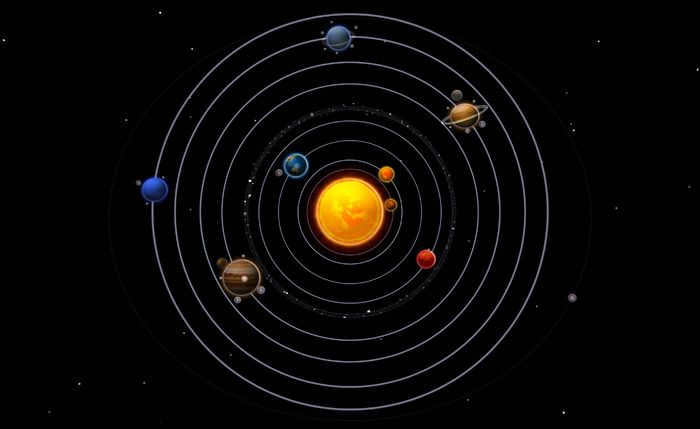
The gas giant planets
Jupiter is the largest planet in our solar system. It is more than 300 times the mass of Earth, even though it is made up mostly of hydrogen and helium gases. Jupiter has a powerful radiation that can have an impact on nearby objects. It also has the most number of satellites – a total of 67. Some of these satellites are large bodies with different compositions.
Jupiter itself is covered in a layer of liquid. Its surface is characterized by numerous parallel bands of light and dark colors, which are actually clouds. Beneath these clouds, powerful winds blow at speeds of up to 600 kilometers per hour. For centuries, astronomers have observed a red spot on Jupiter’s surface, which is a giant storm larger than Earth.
Caution! Jupiter spins on its axis at a faster rate than any other planet in our solar system. A single day on this planet is less than 10 hours long.
Saturn is famously recognized as the planet adorned with magnificent rings. These rings are comprised of icy and dusty particles. The atmosphere of this planet is thick and consists predominantly of hydrogen (over 96%) and helium. Saturn possesses over 60 known moons. Its surface density is the lowest among all the planets in our system, even lower than that of water.
Uranus and Neptune are classified as ice giants due to the abundance of ice on their surfaces, while their atmospheres consist predominantly of hydrogen and helium. Neptune is famously turbulent, whereas Uranus exhibits a comparatively tranquil nature. Being the most distant planet in our solar system, Neptune boasts the longest orbital period, lasting approximately 165 Earth years. Beyond Neptune lies the enigmatic Kuiper Belt, a region teeming with uncharted celestial bodies of diverse compositions and dimensions, serving as the outermost frontier of our cosmic neighborhood.
Space: video
Rewrite the text, making it unique, using the English language and preserving the HTML markup:
Outer Space: video
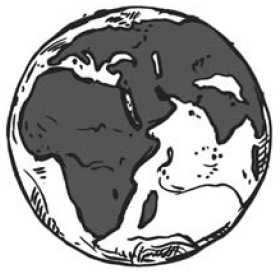
The Earth is an astonishingly magnificent and varied place. It possesses such a sense of belonging and familiarity that we often fail to recognize its unparalleled distinctiveness. Our planet stands alone as the sole celestial entity in the expanses of the observable Universe where life first emerged and continues to thrive. Researchers persistently strive to unravel the mysteries surrounding the precise timing and underlying reasons behind this momentous event on Earth.
For many years, people have been fascinated not only by the history of the Earth, but also by the desire to explore uncharted territories. This curiosity has sparked a wave of discoveries, leading to a tremendous leap in our understanding of the planet. New continents, islands, and oceans have been explored, revolutionizing our perception of the world. While it may seem that there are no more geographical discoveries to be made on Earth, new species, unique natural formations, and evidence of the past continue to be uncovered.
As the world has been explored, its fragility has also been exposed. Since arriving on Earth, humans have been reshaping their surroundings to suit their needs. They constructed cities for comfortable living, cultivated fields to combat hunger, and built factories to manufacture convenient goods. People are constantly altering the planet in an effort to make it more prosperous and secure, but unfortunately, it is becoming increasingly hazardous and impoverished. Today, the Earth still requires exploration, but the focus has shifted from discovering the unknown to finding an optimal balance between the planet and its inhabitants.

The Earth’s Form and Dimensions
Historically, the Earth has been believed to possess a spherical shape. Nevertheless, this notion is not entirely accurate.
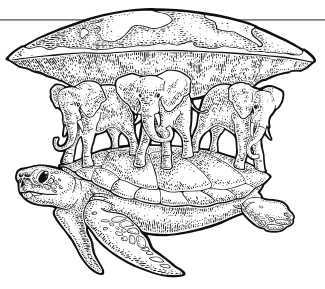
The initial discoverers had the belief that the Earth was flat and existed as a disk that floated on the surface of water. This perception dramatically shifted with the contributions of Aristotle, who not only proposed that our planet has a round shape but also provided evidence to support this theory. Presently, for the sake of simplicity, the Earth is also referred to as a sphere. However, it is widely known that due to its rotation around the axis and the resulting centrifugal force, our planet does not possess a perfectly spherical form.
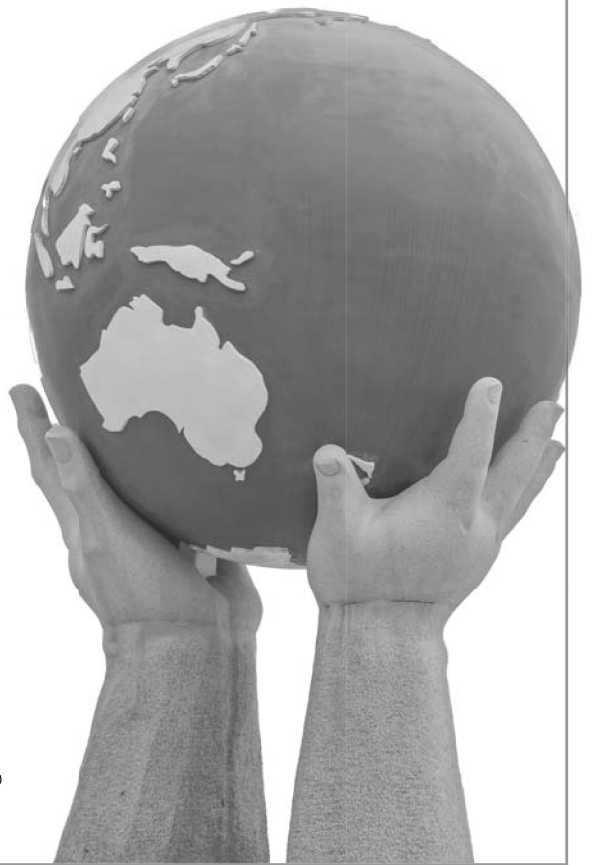
Earth’s characteristics
- Weight – 5.97 x 1024 kg.
- Capacity – 108.3 x 1010 km3.
- Equatorial circumference – 40,075.7 km.
- Meridian circumference – 40,008.5 km.
- Equatorial radius – 6378.2 km.
- Polar radius – 6356.8 km.
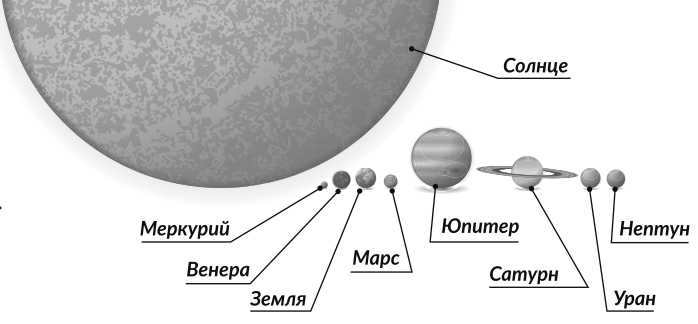
Comparison of the sizes of the Sun, Earth, and other planets in the Solar System
Does the Earth have an elliptical shape?
Originally, it was believed that the Earth is shaped like an ellipsoid – it is asymmetrical and flattened at the poles. This is supported by the fact that the equatorial radius is 21.4 km larger than the polar radius, which is the distance from the center of the Earth to the poles. Furthermore, more precise measurements have shown that the distance from the equator to the North Pole is smaller than the distance to the South Pole.
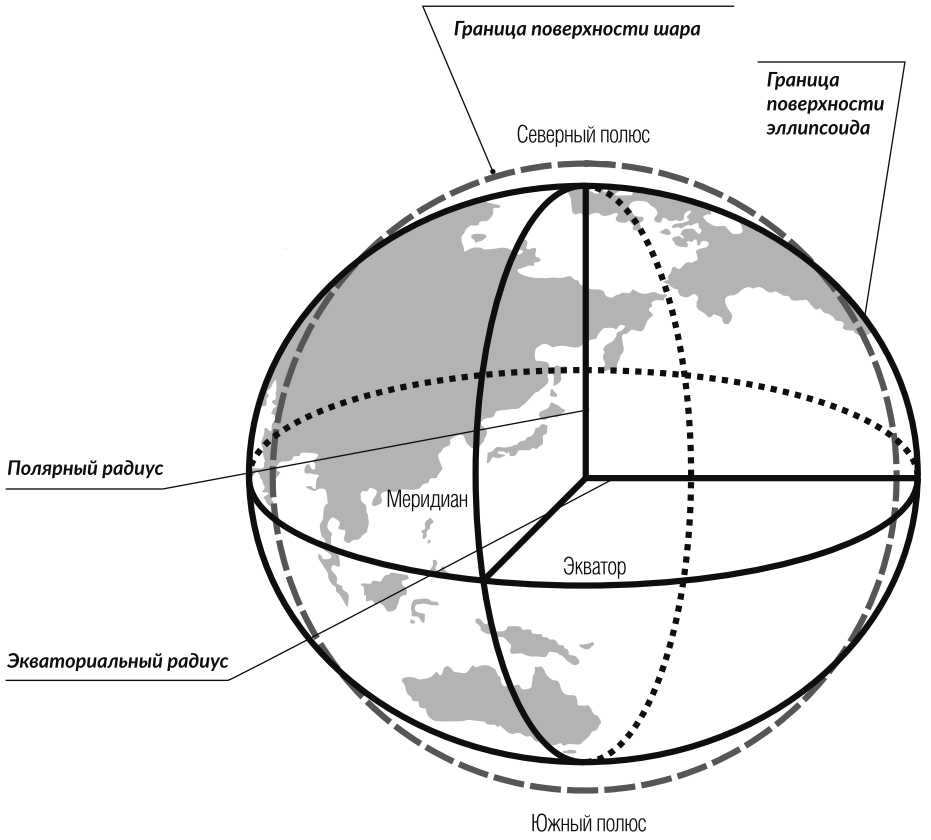
There is a distinct contrast between a ball and an ellipsoid
Is it possible for it to be a geoid in the end?
An ellipsoid (similar to a ball) is an ideal form that the Earth is incapable of achieving. This shape is useful for mathematical computations, hence it is frequently utilized. The actual shape of the Earth deviates greatly from the standard. It is determined by irregularities in the relief of the continents and ocean floor, such as depressions and elevations, and is referred to as a geoid (which translates to “earth-like” in Greek).
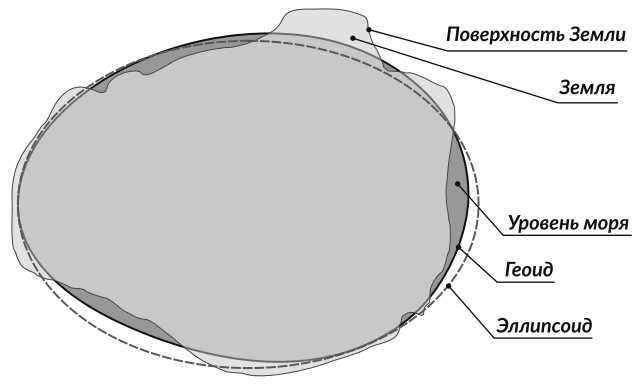
Surface Comparison. The geoid is the Earth’s shape achieved by extending the surface of the world’s oceans beneath the continents.
Earth’s Movement
Across the vast expanse of the universe, amidst countless stars, races the planet we know as Earth. To us, it may seem like an immense world, but that perception is merely an illusion. Amidst the chaos of our daily lives, we seldom gaze up at the sky and fail to realize that in the vast emptiness of space, our planet is nothing more than a grain of sand upon which the miracle of life has flourished.
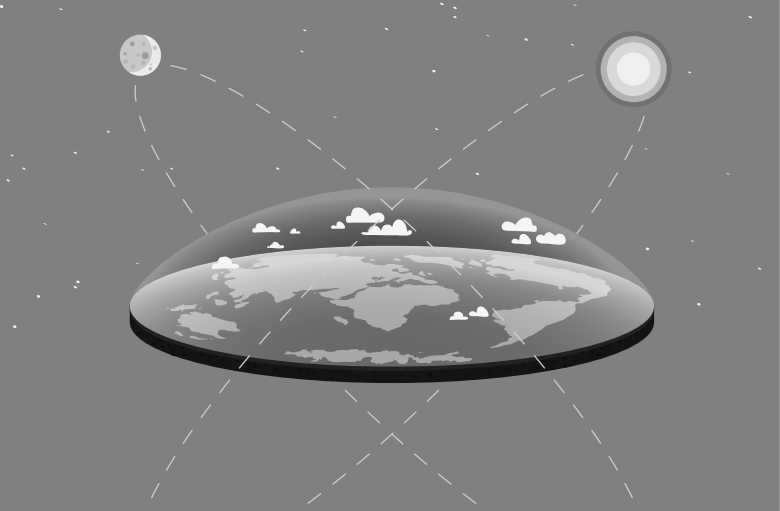
The Earth is an astronomical object, and we are like astronauts on a long journey around the Sun, passing through the vastness of the Universe without even realizing it. Throughout history, mankind has sought to uncover the mysteries of this “spaceship” that we find ourselves on. What is its shape, and how fast is it moving? Thanks to human curiosity, the perseverance of researchers, and the advancements in science and technology, we now have precise answers to nearly all of the Earth’s mysteries.
The Earth, along with the rest of the celestial bodies in our solar system, is in perpetual motion. Motion is synonymous with vitality. This assertion holds true not solely for humanity, but also for our beloved planet. Every passing moment, we traverse the vast expanse of outer space at an approximate velocity of 30 km/s, engaging in not just one, but multiple forms of movement.
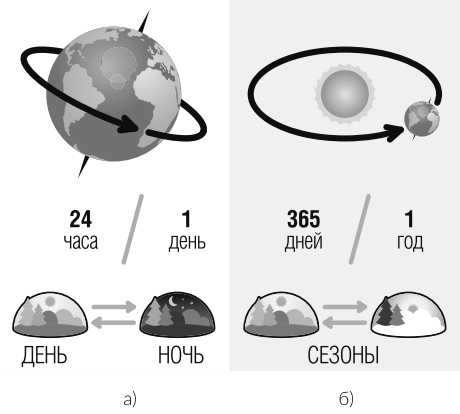

The Earth undergoes two primary forms of motion known as axial rotation and orbital rotation, each with its own set of implications.
The primary and most concrete phenomenon that we experience is the rotation of the Earth on its axis. The cycle of day and night continuously repeats, ensuring the passage of time. It is likely that at some point in their lives, individuals have desired more than 24 hours in a day, as this time frame is not always sufficient for all planned activities. However, it is surprising to discover that time is actually even shorter! The Earth completes one full rotation on its axis in 23 hours, 56 minutes, and 4.1 seconds.
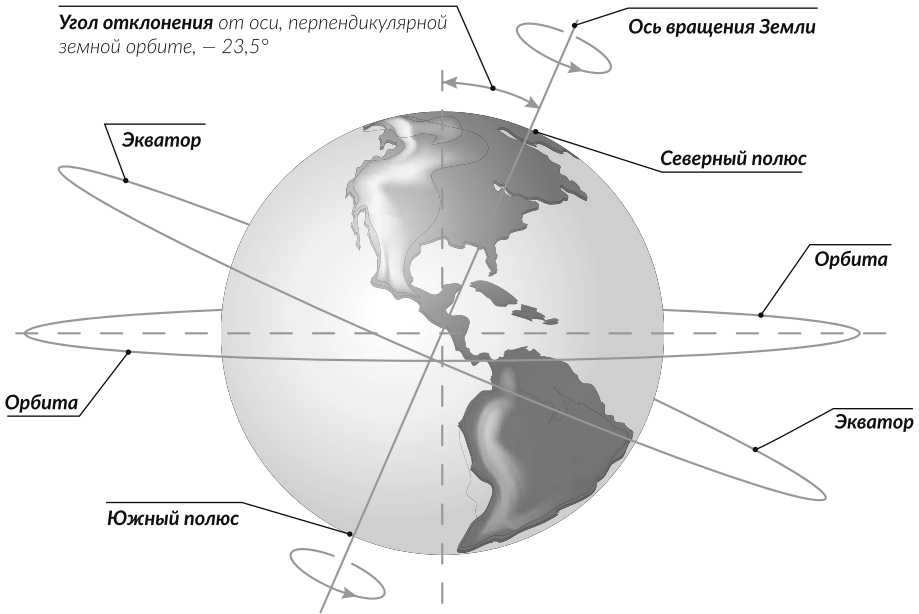

The Earth’s rotation is in an eastward direction
The movement of the Earth around its axis can be compared to a wolf running, as its axis gradually slows down and begins to trace cones in space. While moving through outer space, the Earth’s axis undergoes similar actions, which eventually lead to changes in the positions of celestial bodies in the night sky. The complete cycle of Earth’s precession takes approximately 25,800 years.
Orbital rotation
The second form of movement is orbital rotation. Our planet does not follow a perfectly circular path, but rather an elliptical one with a slight elongation. The point on Earth’s orbit that is closest to our planet is known as the perihelion, while the farthest point is known as the aphelion. We reach aphelion in July and perihelion in January. The Earth doesn’t float in space directly perpendicular to its orbit, but rather at an inclination of 23.5°. The tilt of the Earth’s axis and its orbital rotation result in uneven heating of the planet’s surface throughout the year, leading to the changing of seasons.
If we take into account the Earth’s movements on a cosmic level, we can observe that these intervals do not align with the familiar rounded figures. For instance, the sidereal year, which represents the precise duration of the Earth’s orbit around the Sun, amounts to 365 days and 6 hours. We disregard the surplus six hours over the course of three years. Consequently, these additional hours accumulate and are incorporated into each fourth year, commonly referred to as a leap year..
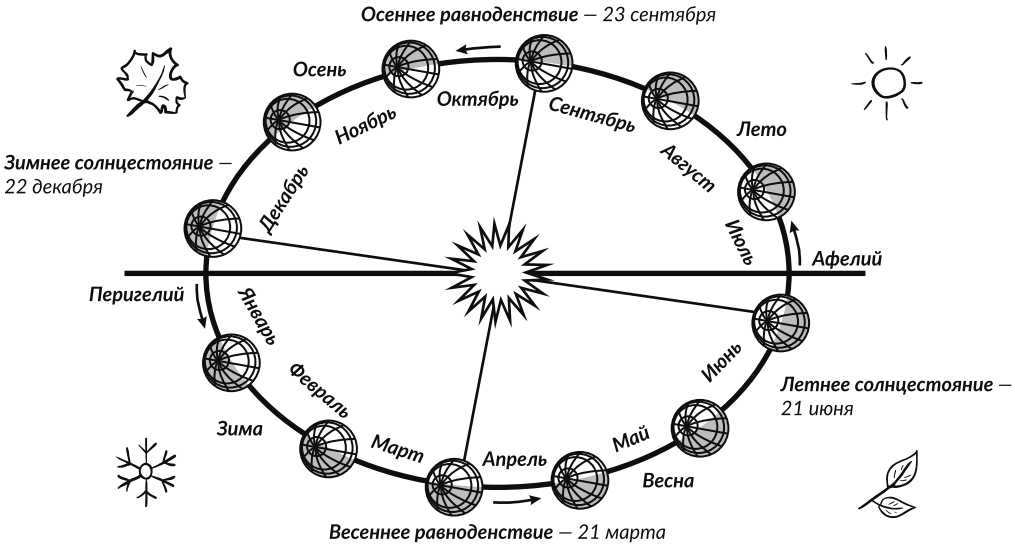

Illustration of the Earth’s orbit around the Sun
Not only does our planet revolve around the Sun, but it also travels with it. The Solar System constantly moves through vast distances of light as it orbits the common center of the Milky Way. The impact of this motion on Earth is not fully comprehended. A complete galactic year lasts approximately 280 million years.
Within our Solar System, we find a magnificent star, the Sun, accompanied by eight distinct planets that orbit around it.
Ranked third among these planets, Earth is the sole known habitable world in our solar system. Life on Earth thrives due to its specific distance from the Sun.
If you enjoy reading this article and find it both informative and entertaining, you may also be interested in learning about how many ribs a cube possesses and the number of nerves found in the human body, as explained by Kidad.
What is the capacity of the Sun in terms of fitting Earth-like planets?
The Sun has an approximate volume of 338 x 10^15 cubic miles (1.40 x 10^18 cubic kilometers), while the Earth has a volume of around 260 x 10^9 cubic miles (1.08 x 10^12 cubic kilometers).
If we perform the necessary calculations, we can determine that the Sun has the capacity to fit approximately 1.3 million Earth-like planets inside. However, it is important to note that this calculation assumes that these planets are tightly packed together, without any empty space. If we were to place perfectly spherical Earth-like planets within the Sun, only 960,000 would be required to fill the available space.
In addition to its immense size, the Sun also possesses an incredible amount of mass. In fact, the mass of the Sun is 330,000 times greater than that of the Earth. Furthermore, the Sun’s mass is 1,000 times greater than even the largest planet in our solar system, Jupiter.
This demonstrates the immense scale of our Sun. It is truly awe-inspiring to realize that numerous stars in the cosmos surpass the size of our Sun. The most colossal star known to us, UY Scuti, possesses a volume that is 5 billion times that of the Sun, which equates to a space capable of containing 650 x 1013 Earths.
A star’s size alters as it progresses through its lifecycle. Many stars transform into red giants as they deplete their hydrogen reserves and expand significantly during their final stages. These red giants can be 100-1000 times larger than our Sun, meaning they could accommodate anywhere from 130 million to 1.3 billion Earths. This serves as evidence that our vast Universe holds even more intrigue than we can fathom.
What is the capacity of the distance from Earth to the Sun?
Due to the immense gap between our home planet and its parent star, the Sun, it appears to us as a large grapefruit compared to Earth.
This distance measures approximately 93 million miles (149 million kilometers), while Earth has a diameter of only 7,917 miles (12,742 km). As a result, the space between the giant ball of gas and our blue planet could accommodate approximately 11,745 Earths.
In contrast, it would take just 107 Suns to fill that same distance. This fact emphasizes the truly immense size of our Sun.
Even more fascinating is the existence of stars larger than our Sun and the abundance of galaxies in the universe that surpass our own in size.
What is the number of Earths that can fit inside the Sun’s diameter?
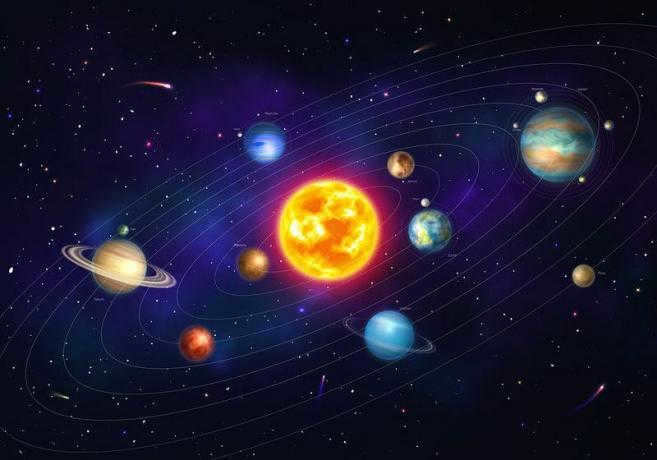
The Sun has an enormous diameter of 865,370 miles (1,392,678 km) and a radius of 432,685 miles (696,339 km).
If we were to line up Earth-sized planets, which have a diameter of about 7,900 miles (12,714 km) and a radius of about 3,950 miles (6,357 km), across the diameter of the Sun, we could fit 109 planets like ours inside the Sun’s diameter.
Jupiter, the largest planet with a radius of 43,440 miles (69,910 km), would only take 10 of them to fill the diameter of the Sun. On the other hand, Mercury, the smallest planet with a radius of 1,516 miles (2,440 km), could fit almost 570 times across the Sun’s diameter.
The Moon, Earth’s natural satellite, is a stunning celestial object that is characterized by its white color and crater-filled surface. It continues to shrink and fill in, creating a captivating sight in our night sky.
With a volume of up to 5.2 billion mi3 (8.4 billion km3), the Moon is just a fraction of the size of the Earth. In fact, it is only one fiftieth the volume of our planet. This means that it would take 50 times the number of Moons to fill the Sun compared to the number of Earths. In other words, the Sun could accommodate a staggering 65 million moons.
When considering the size of the Sun, the largest object in our solar system, it becomes apparent that all other planets and satellites can fit inside it to varying degrees. For instance, it would take seven million Marses, our neighboring planet, to fill the Sun. On the other hand, only 1,000 Jupiters, the largest planet, would be needed to fill the Sun. Interestingly, the smallest planet, Mercury, requires a whopping 23.2 million particles to completely fill the Sun.
At Kidadl, we have curated a wide range of fascinating family trivia just for you! If you found our article on “How Many Earths Can Fit on the Sun? Curious Facts About the Universe for Kids!” interesting, why not check out our piece on identifying spoiled mushrooms or learn about the process of egg fertilization by roosters?
Authored by.
Deepti Reddy is a content writer, travel enthusiast, and a mother of two children aged 12 and 7. With an MBA degree, she has finally discovered her true calling in writing. She finds immense joy in learning new things and expressing her creativity through writing, which she excels at. Her writing portfolio covers a wide range of topics including travel, movies, people, animals and birds, pet care, and parenting. While she has always had a strong interest in traveling, food, experiencing different cultures, and movies, her passion for writing has now become an integral part of her life.
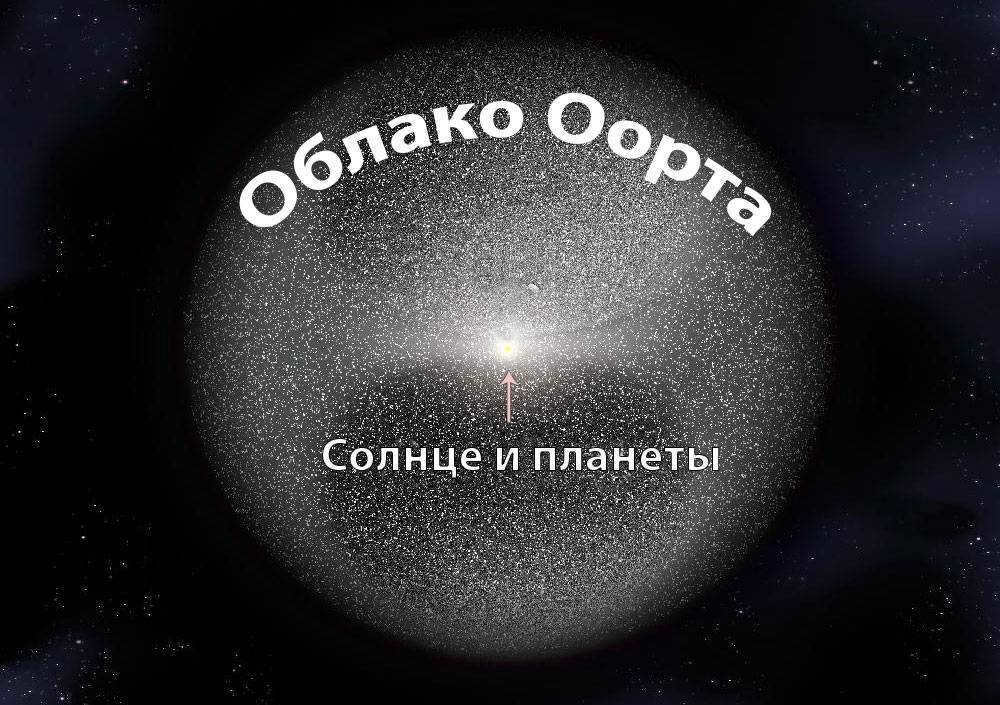
The Sequence of the Planets in the Solar System
The Present Position of the Planets in the Solar System
In 2006, Pluto was removed from the classification of planets due to the presence of objects in the Kuiper Belt that are larger than or equal in size to Pluto. Consequently, if we consider it as a complete celestial object, then it is necessary to include Eridu, which is nearly the same size as Pluto, in this category.
List of the planets in the solar system
The solar system consists of 8 recognized planets, as defined by the MAC (Mercury, Venus, Earth, Mars, Jupiter, Saturn, Uranus, and Neptune).
These planets can be categorized into two groups based on their physical attributes: terrestrial planets and gas giants.
Mercury
The tiniest planet in the solar system has a radius measuring a mere 2440 km. Its orbital period around the Sun, for the sake of simplicity, is equated to one Earth year, which is equivalent to 88 days for Mercury. In comparison, Mercury only completes one and a half rotations on its axis during this time. Hence, a day on Mercury lasts approximately 59 Earth days. There was a longstanding belief that this planet always faced the Sun on the same side, as its visibility from Earth occurred with a periodicity of roughly four Mercurian days. However, this misconception was debunked with the advent of radar studies and continuous observations conducted from space stations. Mercury’s orbit is one of the most unpredictable, as it not only alters its speed of travel and distance from the Sun, but also its very position. Those interested in witnessing this phenomenon can do so.
The reason for Mercury experiencing the greatest temperature fluctuations among the planets in our solar system is its close proximity to the Sun. During the day, the average temperature reaches approximately 350 degrees Celsius, while at night it drops to -170 °C. Analysis of its atmosphere has revealed the presence of sodium, oxygen, helium, potassium, hydrogen, and argon. There is a hypothesis suggesting that Mercury may have once been a moon of Venus, although this theory has yet to be proven. Notably, Mercury does not possess any natural satellites.
Venus
Venus is the second planet from the Sun and has an atmosphere that is composed mainly of carbon dioxide. It is commonly referred to as both the Morning Star and the Evening Star because it is the first star to be visible after sunset and remains visible before dawn, even when all other stars have vanished from sight. The atmosphere of Venus is primarily made up of carbon dioxide, accounting for approximately 96% of its composition. Nitrogen makes up a small percentage, around 4%, and there are also trace amounts of water vapor and oxygen.
This environment produces a greenhouse impact, and the surface temperature is even more elevated than that of Mercury, reaching 475 °C. Known as the most relaxed, a day on Venus lasts for 243 Earth days, which is nearly equal to a Venusian year – 225 Earth days. Many refer to it as Earth’s sibling due to its mass and radius, which are very similar to those of Earth. The radius of Venus is 6052 km (0.85% of Earth’s). Similar to Mercury, it lacks any natural satellites.
Planet Earth
Planet Earth is the third celestial body from the Sun and the exclusive one in our solar system that possesses liquid water on its surface, an essential ingredient for the development of life as we know it. With a radius measuring 6371 kilometers, Earth stands out among its counterparts, as over 70% of its surface is covered by water, leaving the remaining space to be occupied by vast continents. Furthermore, a distinct characteristic of Earth is the presence of tectonic plates hidden beneath its mantle, capable of slow movement, leading to ever-changing landscapes over time. This dynamic planet moves at a speed of approximately 29-30 kilometers per second.
Mars
Mars, the fourth planet from the Sun, is renowned for its unique and rarefied atmosphere. Since 1960, scientists from various countries, including the USSR and the United States, have actively explored Mars. While not all exploration programs have achieved success, the discovery of water in certain areas suggests the possibility of primitive life existing or having existed on the planet.
One remarkable feature of Mars is its brightness, which allows it to be visible from Earth without the need for any instruments. During the opposition, which occurs every 15-17 years, Mars becomes the brightest object in the sky, even outshining Jupiter and Venus.
With a radius of approximately half that of Earth’s, Mars measures around 3390 km. However, its year is significantly longer, spanning 687 days. Mars also has two satellites, namely Phobos and Deimos.
A representation of the solar system
Attention! The animation is only functional in browsers that support the -webkit standard (such as Google Chrome, Opera, or Safari).
The massive planets
There are four enormous gas planets situated past Mars’ orbit: Jupiter, Saturn, Uranus, and Neptune. These planets are found in the outer regions of the solar system and vary in terms of their mass and gas composition.
Jupiter
Jupiter is the largest planet in our solar system, located fifth from the Sun. It has a radius of 69,912 kilometers, making it 19 times larger than Earth and only 10 times smaller than the Sun. The length of a year on Jupiter is not the longest in our solar system, lasting only 4,333 Earth days (which is equivalent to about 12 Earth years). A day on Jupiter is relatively short, lasting approximately 10 Earth hours. While the exact composition of Jupiter’s surface is still unknown, it is believed to contain higher concentrations of krypton, argon, and xenon compared to the Sun.
There is a belief that one of the four gas giants is actually a failed star. Supporting this theory is the fact that Jupiter has a large number of satellites – a total of 67. To understand how these satellites behave in Jupiter’s orbit, a precise and clear model of the solar system is needed. The largest satellites of Jupiter are Callisto, Ganymede, Io, and Europa. Among them, Ganymede is the largest satellite of any planet in the entire solar system, with a radius of 2634 km. This makes it 8% larger than Mercury, the smallest planet in our system. Notably, Io is one of three satellites that have an atmosphere.
Saturn, the second largest planet in the solar system and the sixth largest overall, bears the closest resemblance to the Sun in terms of its chemical composition. With a surface radius of 57,350 kilometers and a year lasting 10,759 days (nearly 30 Earth years), Saturn’s days are slightly longer than those of Jupiter, lasting 10.5 Earth hours. While it has slightly fewer satellites than its neighbor, with 62 compared to Jupiter’s 67, Saturn is home to some of the most notable satellites in the solar system. Titan, the largest satellite of Saturn, shares this distinction with Io, both of which possess atmospheres. Other well-known satellites of Saturn include Enceladus, Rhea, Dione, Tefia, Japet, and Mimas, which, although slightly smaller in size, are equally renowned. These satellites are the most frequently observed objects and therefore have been the subject of extensive study in comparison to other celestial bodies.
For many years, Saturn’s rings were believed to be an exclusive and distinct phenomenon. However, it has recently come to light that all gas giants possess rings, although they may not be as prominent as Saturn’s. The exact origins of these rings remain unknown, although various theories have been proposed to explain their formation. Interestingly, it has also been revealed that Rhea, one of Saturn’s moons, possesses a ring-like structure of its own.
Uranus
Uranus is the seventh largest planet in our solar system, with a radius of 25267 km. It is also the third largest planet. One interesting fact about Uranus is that it is the coldest planet, with temperatures dropping as low as -224 degrees Celsius. In terms of its year, it takes approximately 30,685 days for Uranus to complete one orbit around the sun, which is equivalent to almost 84 Earth years. A day on Uranus is not much shorter than a day on Earth, lasting around 17 hours.
One unique feature of Uranus is its strong axis inclination. This gives the planet a rolling motion, making it appear different from other celestial bodies in our solar system. If you are interested in astronomy, you can observe this effect through a geometric model of the solar system.
Unlike its neighbor Saturn, Uranus has a smaller number of satellites. It only has 27 satellites, with the most well-known ones being Titania, Ariel, Oberon, Umbriel, and Miranda. Although they are not as large as Saturn’s satellites, they still play an important role in studying Uranus.
Interestingly, when astronomer William Herschel observed Uranus through his telescope, he initially mistook it for a comet rather than realizing it was a planet.
Mercury
This tiny planet has a radius of 2,440 kilometers. Mercury lacks any moons and completes a full orbit around the Sun in just half the time it takes for a day on Earth (88 days).
Mercury’s thin crust is composed of craters that have been found to contain ice by scientists. This discovery supports the possibility of life on the planet, although the atmosphere on Mercury is extremely thin. It is possible that the planet’s atmospheric layer was blown away following a massive collision.
Venus
The second planet has a mass similar to that of Earth. Interestingly, Venus is the only celestial body that rotates in the opposite direction. Furthermore, its rotation is incredibly slow – a day on Venus is equal to 243 Earth days.
The planet’s atmosphere is highly dense due to the abundance of carbon dioxide, resulting in a greenhouse effect. As a result, temperatures on Venus can reach up to 400 ° C. Additionally, Venus experiences frequent and intense thunderstorms that surpass those on Earth. While Venus does not have any natural satellites, there is a hypothesis that one of them was once Mercury.
The hydrosphere makes the third planet from the Sun unique. Only on Earth does water account for 70% of the planet’s surface, with the remaining area being land. Additionally, Earth is distinguished by the presence of tectonic plates that shift beneath the mantle and alter the landscape.
Compared to other planets, Earth is relatively slow. It takes 365 days to complete a full orbit around the Sun, but only 24 hours to complete a full rotation on its axis. The magnetic core of the planet serves as a protective shield against nuclear radiation. Without this protective layer, a solar strike would annihilate all life on Earth.
Further reading: How many planets are there in our solar system?
Mars
Mars is the fourth planet in the Earth group. It is slightly smaller in size compared to Earth. In our solar system, there are a total of eight planets, but Mars stands out as the focus of extensive scientific research over many years. This is primarily due to the discovery of beds on the planet, indicating the presence of liquid in the past.
Scientists posit that Mars may have sustained life in the past, but the destructive effects of solar activity led to the extinction of all living organisms. Notably, Mars is home to Olympus, the largest volcano in our solar system. The planet’s distinct red appearance is attributed to its high iron content in the soil.
Jupiter
Jupiter is classified as a gas giant due to its immense size. In fact, it is so massive that it could accommodate 1,300 planets similar in size to Earth. However, its extraordinary dimensions are not its only distinguishing feature. The gravitational force on Jupiter’s surface is also 2.5 times stronger than that of Earth. Consequently, if a person weighing 100 kilograms were to stand on Jupiter, their weight would increase to a staggering 250 kilograms.
One of Jupiter’s notable attributes is its powerful magnetic field, which enables it to attract and divert asteroids. Additionally, the planet is characterized by a prominent feature known as the “Great Red Spot,” believed to be a hurricane that has been raging for centuries. Furthermore, Jupiter boasts an impressive array of satellites, with a total of 29 orbiting around it.
Saturn
Saturn is the second largest planet in the solar system, following Jupiter. It is known for having the lowest density among all the planets. Saturn is primarily composed of hydrogen and helium. Only four spacecraft have ever been sent to explore this celestial body. The length of a year on Saturn is equivalent to 30 Earth years.
One distinctive feature of Saturn is its strong wind speeds, which can reach up to 500 m/s. These winds create visible yellow stripes in the planet’s atmosphere. Scientists have also observed a massive storm above Saturn’s north pole, which is larger in diameter than Earth and is believed to be a gigantic hurricane.
The planets in our solar system are truly unique and fascinating. One of the most intriguing planets is Uranus, which stands out for its extreme cold temperatures. In fact, Uranus holds the title for being the coldest planet, with temperatures dropping as low as -225 °C. But that’s not the only thing that sets Uranus apart.
Unlike the other planets in our solar system, Uranus rotates on its side. Its axis is tilted at an astonishing 98 degrees, making it the only planet to have such a peculiar orientation. Furthermore, Uranus is the second densest planet, just behind Saturn. This means that if you were standing on Uranus, you would only experience about 89% of Earth’s gravity.
Uranus also has an impressive number of satellites, with a total of 27 orbiting around it. And if you ever find yourself on Uranus, get ready for a long day. A day on Uranus lasts approximately 17 hours, which is quite different from the 24-hour days we are accustomed to on Earth.
Perhaps one of the most unique features of Uranus is its strong tilt, which causes one pole to constantly face the Sun. This means that on Uranus, day and darkness each last a staggering 42 years. Can you imagine experiencing 42 years of daylight or darkness? It truly is a remarkable phenomenon that sets Uranus apart from all the other planets in our solar system.
Neptune: A Unique and Mysterious Planet
Neptune’s distinctive blue color is attributed to its high methane content. Unlike other planets, Neptune lacks a solid crust and instead has an atmosphere that transitions into a liquid state. Despite its gaseous composition, Neptune’s gravity is only 17% stronger than that of Earth’s.
The planet is known for its powerful hurricanes, with wind speeds reaching up to 2,100 kilometers per hour. These storms are fueled by the intense heat generated by Neptune’s core, which surpasses the amount of heat it receives from the Sun. To date, only one spacecraft has been sent to explore Neptune, and there are currently no plans for future missions.
The solar system’s arrangement of planets is a fascinating subject. Each planet possesses its own unique characteristics, yet there are also similarities among them. As humanity continues to delve into space exploration, there is still much to discover and perhaps even find a planet suitable for sustaining life within our solar system.
Read also: Fascinating Facts about Mars, the Red Planet
Structure of the solar system
Sun
The Sun contains approximately 99.9% of the total mass of the solar system. This celestial body consists primarily of hydrogen and helium. In essence, it functions as a massive fusion reactor. The surface temperature of the Sun is estimated to be around 6,000 °C, while its internal heat reaches an astonishing 10,000,000 °C.
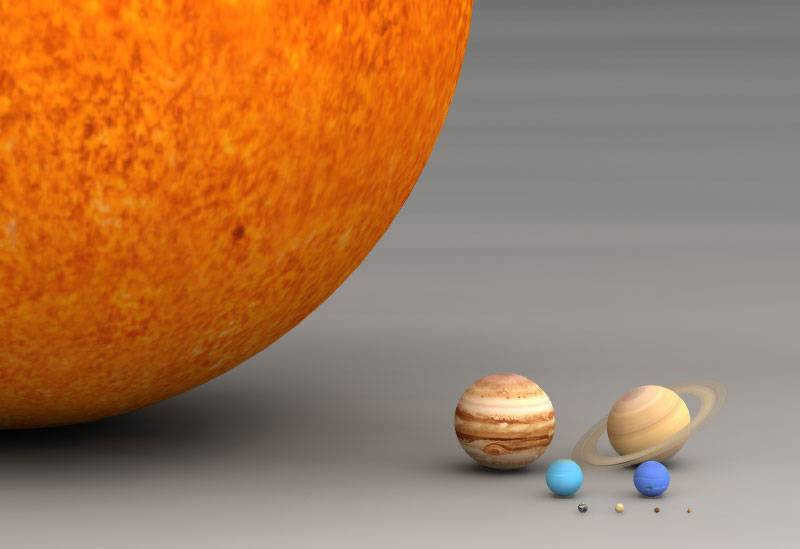
Our star is moving through space at a velocity of 250 kilometers per second as it orbits around the center of the galaxy, which is situated a mere 26,000 light years from us. Furthermore, it takes approximately 180 million years for one complete revolution.
Planets and their moons

Group of Earth.
Mercury
Mercury is the planet that is closest to the Sun and also the smallest in our solar system. It has a very slow rotation, making only one and a half revolutions around its axis for a full revolution around the Sun. Unlike other planets, Mercury does not have an atmosphere or any satellites. During the day, the temperature on Mercury can reach up to +430 ° C, while at night it cools down to as low as -180 ° C.
Venus
Venus, the planet closest to Earth and known for its romantic allure, is unfortunately uninhabitable. Its atmosphere is dominated by a dense layer of carbon dioxide clouds, creating extreme temperatures that can reach up to +475 degrees Celsius. The surface of Venus is also heavily cratered and experiences a pressure of over 90 atmospheres. Despite these harsh conditions, Venus is similar in size and mass to Earth.
Mars
Mars is structurally similar to our planet. It has a radius that is half the size of Earth and a mass that is about ten times smaller. While it would be theoretically possible for humans to live on Mars, the lack of water and atmosphere make it inhospitable. One interesting fact about Mars is that its year is twice as long as Earth’s, but its day is almost the same length. Mars is also unique in that it has two satellites, Phobos and Deimos, which are named after the Greek words for “fear” and “terror”. These satellites are small rocky bodies that resemble asteroids.
Jupiter
The largest gas giant planet. If it were to have a few dozen times its mass, it could potentially undergo the process of stellar ignition and become a star. The duration of a day on this magnificent planet is approximately 10 hours, while a complete orbit around the sun takes merely 12 Earth hours. Similar to Saturn and Uranus, Jupiter possesses a magnificent ring system. Although it consists of four rings, they are not particularly prominent and can go unnoticed from a distance. However, this remarkable celestial body boasts a staggering number of over 60 satellites.
Saturn
Saturn is the most ringed planet in the solar system. It also possesses a unique characteristic that sets it apart from other planets: its density. With a density of less than one, if Saturn were to be dropped into a massive ocean, it would not sink. Over 60 satellites have been discovered orbiting this colossal planet, with the main ones being Titan, Enceladus, Dione, and Tefia. Saturn shares a similar atmospheric structure with Jupiter.
Uranus
What makes Uranus unique is its distinct blue-green color and its peculiar rotation. Unlike other planets, Uranus rotates on an axis that is almost parallel to the ecliptic plane, causing it to appear as if it is lying on its side. However, this unique orientation hasn’t stopped Uranus from acquiring 13 rings and 27 companions. Among its most well-known companions are Oberon, Titania, Ariel, and Umbriel.
Neptune
Similar to Uranus, Neptune is made up of a gas mixture containing water, ammonia, and methane. The presence of methane in the atmosphere gives the planet its distinct blue hue. Neptune possesses a system of 5 rings and is orbited by 13 satellites. Notable satellites include Triton, Proteus, Larissa, and Nereida.
Pluto
Pluto is the largest of the dwarf planets. It is composed of a rocky core covered by a layer of ice. It was not until 2015 that a spacecraft successfully reached Pluto and captured detailed photographs. Charon is its primary satellite.
The Kuiper Belt. This region is a part of our solar system that extends from 30 to 50 astronomical units (AU) from the Sun. It is a collection of small bodies, primarily composed of ice, such as methane, ammonia, and water. However, there are also objects within the Kuiper Belt that consist of rocks and metals.
Asteroids. These are rocky or metallic objects that orbit the Sun, mostly within the plane of the ecliptic. Some asteroids have orbits that intersect with the Earth’s orbit. Although the chances of a collision are very low, it is believed that such an event occurred approximately 65 million years ago.
According to legend, the planet Phaethon was peacefully orbiting the Sun until it was torn apart by Jupiter’s gravity, resulting in the formation of the beautiful asteroid belt. However, this theory has not been scientifically confirmed.
Comets. When you translate that word from Greek, you get “long-haired.” And that’s exactly what they are. When these icy wanderers come close to the Sun, they release vaporizing gases that form a long tail extending for hundreds of millions of kilometers. Comets also have a head, which consists of a nucleus and a coma. The nucleus is a frozen block of icy gases with some silicates and metal particles mixed in. There may also be some organic materials present. The coma is the gas and dust surrounding the comet.
The Oort cloud. In 1950, Jan Oort proposed the existence of a cloud filled with objects made of icy ammonia, methane, and water. While it hasn’t been proven yet, it’s believed that the cloud starts at 2 – 5 thousand astronomical units and extends all the way to 50 thousand astronomical units. Most comets are thought to originate from the Oort cloud.

The position of Earth in the solar system
No other position in the universe can be considered luckier than the one occupied by Earth. The region where our galaxy is located is remarkably peaceful and serene. The Sun, our closest star, provides a steady and consistent luminosity. It emits precisely the necessary amount of heat, radiation, and energy that is essential for the formation and progression of life. It’s almost as if the Earth itself was meticulously designed in advance. Its atmospheric composition and geological structure are perfectly suited for sustaining life. The background radiation and temperature conditions are precisely calibrated for optimal living conditions. Additionally, the presence of water with its extraordinary properties further enhances the prospects for life. Furthermore, the Moon, with its ideal mass and distance from Earth, plays a vital role in maintaining the stability of our planet. There are numerous other fortuitous circumstances that are fundamental for the existence of life on Earth. Any significant deviation from these conditions would greatly diminish the likelihood of life emerging and surviving.





